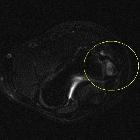Little leaguer's elbow


The little leaguer's elbow was initially coined to describe medial epicondyle avulsion, but more recently it refers to a range of acquired elbow abnormalities in a skeletally immature patient engaged in overhead sports such as tennis, baseball, etc.
Epidemiology
It occurs in skeletally immature athletes before the closure of growth plates. Younger patients are more likely to develop avulsion injury or apophysitis than ligament injuries.
Clinical presentation
The presentation includes: pain in a throwing arm, decreased throwing speed, power, and accuracy. Physical examination may reveal medial and proximal elbow focal tenderness. Applying valgus forces to the elbow may worsen the symptoms and, in severe cases, may show instability.
Pathology
Forceful throwing or overhead strokes generates extreme valgus and extension with tensile forces in the medial elbow, shear forces in the posterior compartment, and compressive stress on the lateral aspect of the joint.
Radiographic features
- medial epicondyle apophysitis:
- widening of the physis with adjacent sclerosis and cortical irregularity. MRI may show increased fluid signal and widening of the physis with apophyseal edema-like lesions
- in severe cases, fragmentation and avulsion fracture may occur
- by advancing age and skeletal maturity, injurers of ulnar collateral ligament become more prevalent
- In younger children due to higher elastin and low type I collagen content, slightly high T1 and T2 signal within the ligament is considered normal and should not be mistaken for tear or tendinopathy
- Panner disease: benign self-limiting osteochondrosis of capitulum secondary ossification center in patients <12 years
- osteochondritis dissecans (OCD) of the capitellum: usually in more mature patients older than 12 years of age
- traction apophysitis of the olecranon
Treatment and prognosis
Treatment depends on the type of injury. If conservative management fails surgical option would be considered. Avulsion fractures and large OCD lesions may be treated surgically.
See also

